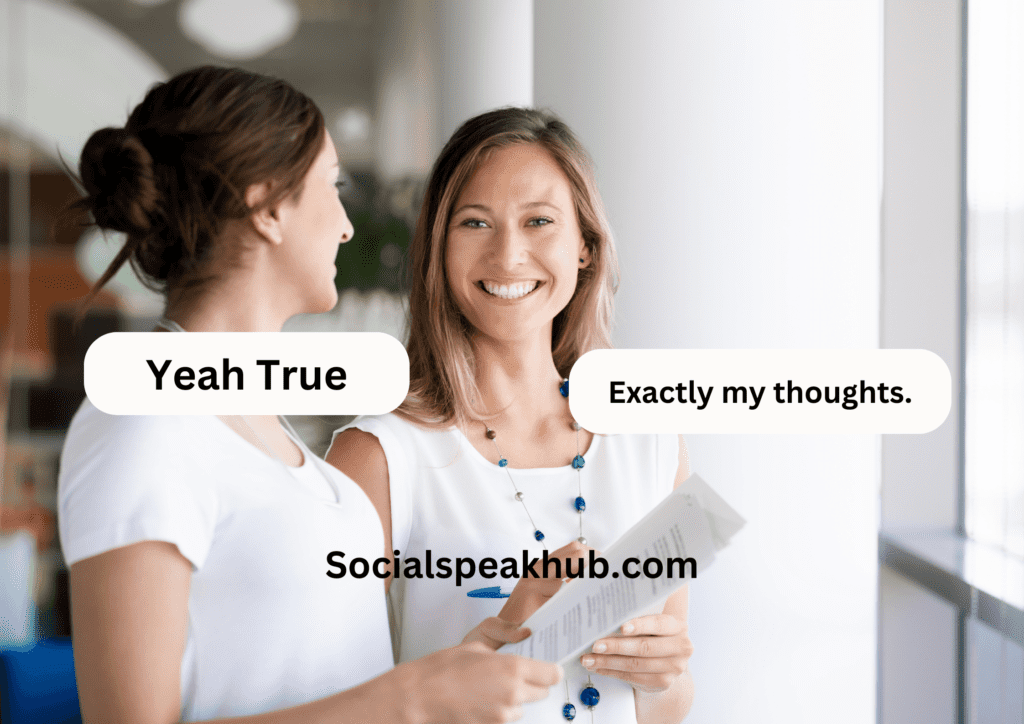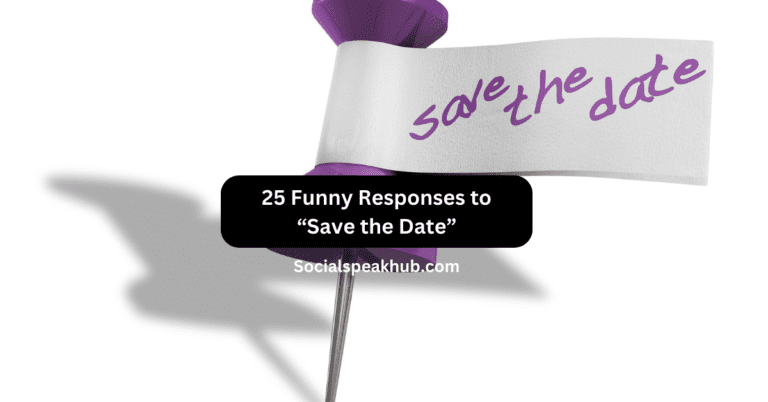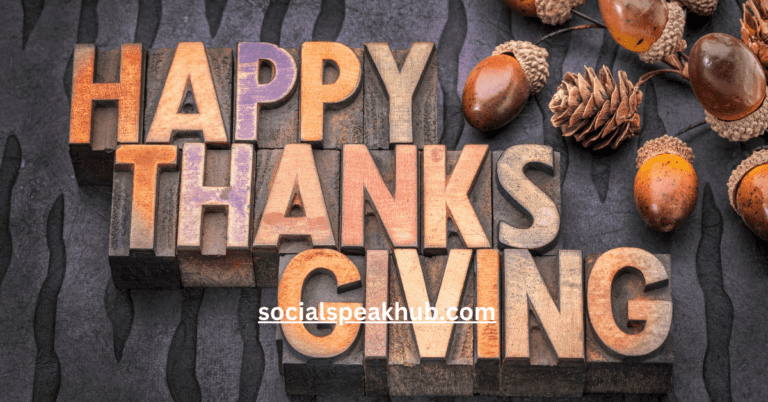25 Best Responses to Yeah True
In the dynamic landscape of human interactions, expressing agreement is an art form that transcends mere acknowledgment. Responding with a simple “Yeah, true” has evolved into a nuanced exchange where words matter. In this exploration, we delve into the 25 best responses that elevate agreement from a mere formality to an engaging dialogue.
Table of Contents
25 Best Responses to Yeah True
- 1. “Absolutely, couldn’t agree more.”
- 2. “You’ve got a point there.”
- 3. “Spot on!”
- 4. “No doubt about it.”
- 5. “That’s the reality of it.”
- 6. “Exactly my thoughts.”
- 7. “True story.”
- 8. “You took the words right out of my mouth.”
- 9. “You’re right on the money.”
- 10. “Couldn’t have said it better myself.”
- 11. “100% true.”
- 12. “My sentiments exactly.”
- 13. “You hit the nail on the head.”
- 14. “I’m with you on that.”
- 15. “You’re absolutely correct.”
- 16. “Tell me about it.”
- 17. “You read my mind.”
- 18. “I couldn’t agree more.”
- 19. “Right on the mark.”
- 20. “That’s the truth, no doubt.”
- 21. “I’m on the same page.”
- 22. “Couldn’t have put it better.”
- 23. “You’re speaking my language.”
- 24. “Precisely.”
- 25. “Absolutely, and then some.”
1. “Absolutely, couldn’t agree more.”

This response, “Absolutely, couldn’t agree more,” shows a strong agreement between two people. The word “absolutely” makes it clear that there is complete agreement, and the phrase “couldn’t agree more” emphasizes that the person fully supports what was said. It’s like saying, “I totally agree with you, and I couldn’t agree any more than I already do.” This simple and straightforward response highlights a strong shared viewpoint.
2. “You’ve got a point there.”
This reply, “You’ve got a point there,” means the person agrees with what someone else said because they see the validity or correctness in it. By saying “you’ve got a point,” they are acknowledging that the other person has a valid argument or perspective. This response is a way of showing understanding and agreement, creating a connection by appreciating the merit in the other person’s point of view.
3. “Spot on!”
The expression “Spot on!” is a way of saying that someone is exactly right. It goes beyond just agreeing; it also conveys admiration for the accuracy of what was said. By using “spot on,” the person is highlighting that the statement or observation is perfectly correct. It’s a concise and enthusiastic way of expressing agreement while appreciating the precision of the other person’s remark.
4. “No doubt about it.”
When someone says, “No doubt about it,” they are expressing absolute certainty and removing any possibility of doubt regarding the statement at hand. This response strongly affirms agreement with unwavering conviction, emphasizing complete confidence in the truthfulness or accuracy of what was said. It’s a straightforward way of saying, “I completely agree, and there is no question or uncertainty about it.”
5. “That’s the reality of it.”
Saying “That’s the reality of it” is a way of agreeing while recognizing a common understanding of the situation. This response implies that the statement aligns with the shared experiences or facts of a situation. It acknowledges not just agreement but also a recognition that what was said reflects the reality that both parties understand or have experienced. It’s a way of saying, “I agree with you, and this aligns with how things really are.”
6. “Exactly my thoughts.”

When someone says, “Exactly my thoughts,” they are expressing more than agreement; they are implying a deep connection of understanding. This response suggests that the speaker’s thoughts align perfectly with what was just expressed, almost as if there’s a shared mental connection. It goes beyond a simple acknowledgment of agreement and indicates a profound level of understanding or shared perspective. In essence, it expresses, “I not only align with your viewpoint, but your words echo my exact sentiments.”
7. “True story.”
When someone says, “True story,” they are expressing agreement in a casual and authentic way. This response maintains a conversational tone while affirming that what was said is indeed true or accurate. It adds a touch of relatability to the agreement, making the interaction feel more informal and genuine. Essentially, it’s a way of saying, “I agree with you, and what you said is absolutely true.”
8. “You took the words right out of my mouth.”
When someone says, “You took the words right out of my mouth,” they are expressing not only agreement but also a sense of shared expression. This response implies that the other person articulated exactly what the speaker was thinking or feeling. It conveys a strong resonance with the words spoken, creating a sense of unity and understanding. Essentially, it’s a way of saying, “I completely agree with you, and you expressed my thoughts perfectly.”
9. “You’re right on the money.”
When someone says, “You’re right on the money,” they are expressing agreement with a touch of financial metaphor. This response suggests that the other person’s words are not just accurate but hit the mark with precision, much like a successful financial transaction. It adds a flair of assurance and emphasis, indicating that the speaker believes the statement is not only correct but precisely so. In essence, it’s a way of saying, “I completely agree, and your statement is spot-on and accurate.”
10. “Couldn’t have said it better myself.”
When someone says, “Couldn’t have said it better myself,” they are expressing not only agreement but also admiration for the eloquence or precision of the other person’s words. This response goes beyond a simple acknowledgment and adds a touch of humility, suggesting that the speaker finds the expressed sentiment so well-stated that they couldn’t improve upon it. Essentially, it conveys, “I completely agree, and your expression of it is so perfect that I couldn’t have articulated it any better.”
11. “100% true.”
When someone says, “100% true,” they are expressing unwavering and complete agreement. The use of “100%” leaves no room for doubt or ambiguity, emphasizing the thorough alignment of perspectives. It’s a straightforward way of stating that the person not only agrees but does so wholeheartedly, affirming the absolute truthfulness or accuracy of the statement. In essence, it signifies my complete agreement with every aspect of your statement, devoid of any reservations.
12. “My sentiments exactly.”

When someone says, “My sentiments exactly,” they are expressing more than agreement, they are indicating a shared emotional connection or resonance with the expressed thoughts. This response suggests that the speaker not only agrees intellectually but also feels the same way on a personal or emotional level. It goes beyond the surface meaning of the words and conveys a sense of deep understanding and connection. Essentially, it means, “I not only agree with you, but I share the same feelings or sentiments as well.”
13. “You hit the nail on the head.”
When someone says, “You hit the nail on the head,” they are metaphorically expressing agreement while suggesting that the other person’s words have accurately identified a central truth or point. This response adds a vivid layer of imagery, implying that the statement is not just accurate but precisely on target. It involves expressing full concurrence and acknowledging that you’ve precisely identified the essential element of the issue.
14. “I’m with you on that.”
When someone says, “I’m with you on that,” they are expressing agreement in a way that goes beyond verbal acknowledgment. This response fosters a sense of camaraderie and togetherness, implying that the speaker not only agrees but is also aligned with the other person in a broader sense. It suggests a shared journey or stance, creating a connection that extends beyond the specific point of agreement. Essentially, it means, “I not only agree with you, but I also stand alongside you on this matter.”
15. “You’re absolutely correct.”
When someone says, “You’re absolutely correct,” they are expressing agreement in a formal and authoritative manner. This response not only affirms agreement but also acknowledges the correctness of the other person’s statement with a touch of formality. It conveys a sense of precision and accuracy, emphasizing that the speaker believes the statement to be entirely true. Essentially, it means, “I agree with you, and your statement is completely accurate.”
16. “Tell me about it.”
When someone says, “Tell me about it,” they are not only expressing agreement but also inviting the speaker to elaborate and share more details. This response transforms simple agreement into a shared narrative, indicating a desire for a deeper conversation about the agreed-upon point. It suggests that the speaker not only agrees but is also interested in hearing more, fostering a sense of engagement and discussion. In essence, it signifies my concurrence and eagerness to delve deeper into your viewpoint or experiences regarding this subject.
17. “You read my mind.”
When someone says, “You read my mind,” they are expressing more than agreement; they are suggesting a shared thought process or understanding that goes beyond verbal communication. This response adds a layer of intrigue and connection, implying that the other person has accurately grasped the speaker’s thoughts without them being explicitly stated. It transcends simple verbal affirmation and conveys a sense of shared intuition. In essence, it signifies, “I not just concur; it’s like you grasp my thoughts without them needing utterance.”
18. “I couldn’t agree more.”

When someone says, “I couldn’t agree more,” they are expressing strong agreement with a touch of simplicity. This response conveys complete alignment with the other person’s statement while embracing the straightforwardness of the expression. It’s a concise way of affirming that the speaker shares the same viewpoint and couldn’t agree any more than they already do. In essence, it signifies complete agreement on my part, leaving no space for disagreement.
19. “Right on the mark.”
When someone says, “Right on the mark,” they are expressing agreement while suggesting that the other person’s words have hit a metaphorical target with accuracy. This response combines the notion of agreement with a sense of precision, indicating that the speaker believes the statement is not just correct but precisely so. It’s a way of saying, “I completely agree with you, and your words have accurately captured the essence of the matter.”
20. “That’s the truth, no doubt.”
When someone says, “That’s the truth, no doubt,” they are expressing agreement with strong conviction while emphasizing the statement as an undeniable truth. This response leaves no room for skepticism or disagreement, making it clear that the speaker is fully aligned with the asserted truthfulness of the statement. In essence, it signifies my wholehearted agreement, leaving no room for doubt that your statement holds undeniable truth.
21. “I’m on the same page.”
When someone says, “I’m on the same page,” they are expressing agreement while indicating a shared mental space or alignment in perspectives. This response goes beyond a simple acknowledgment of agreement; it implies that the speaker and the other person are in sync, sharing a common understanding or viewpoint. It fosters a sense of unity and connection in the way they perceive a particular issue or idea. Essentially, it means, “I agree with you, and we both share a similar understanding or perspective on this matter.”
22. “Couldn’t have put it better.”
When someone says, “Couldn’t have put it better,” they are expressing agreement with a touch of admiration for the speaker’s eloquence. This response acknowledges that the other person has articulated the message so well that the speaker couldn’t improve upon it. It combines agreement with a compliment, emphasizing not only alignment with the conveyed message but also appreciation for how it was expressed. In essence, it signifies, “I wholeheartedly concur with your perspective, and your choice of words was so adept that I couldn’t have articulated it more effectively on my own.”
23. “You’re speaking my language.”
When someone says, “You’re speaking my language,” they are expressing agreement while implying a shared linguistic or conceptual understanding. This response goes beyond the words spoken, suggesting that the speaker not only agrees but also feels a harmonious resonance with the way the message is conveyed. It conveys a sense of connection and camaraderie, indicating that the speaker not only understands the words but also appreciates the manner in which they are presented. Essentially, it means, “I agree with you, and your communication style or perspective resonates well with me.”
24. “Precisely.”

When someone says, “Precisely,” they are expressing agreement with a concise and exacting tone. This response cuts through ambiguity and implies exact alignment with the speaker’s words, emphasizing precision. It conveys a clear and straightforward acknowledgment that the speaker’s statement is accurate and aligns perfectly with the responder’s perspective. Essentially, it means, “I agree with you completely, and your statement is precisely on point.”
25. “Absolutely, and then some.”
When someone says, “Absolutely, and then some,” they are expressing agreement with a heightened sense of abundance. This response goes beyond the expected level of agreement and suggests not just alignment but an amplification of agreement. It adds an extra layer of emphasis, indicating that the speaker not only agrees but does so enthusiastically and with an extra measure of affirmation. Essentially, it means, “I wholeheartedly agree with you, and my agreement goes even beyond what might be expected.”
Conclusion
In the tapestry of human communication, the art of agreement weaves connections that go beyond words. The 25 responses explored here go beyond mere acknowledgment, transforming agreement into a dynamic exchange. Whether through precision, admiration, or shared understanding, these responses add depth and nuance to the simple phrase, “Yeah, true.” Mastering this art enriches conversations, fostering a sense of unity and shared perspectives in the diverse tapestry of human interaction.






